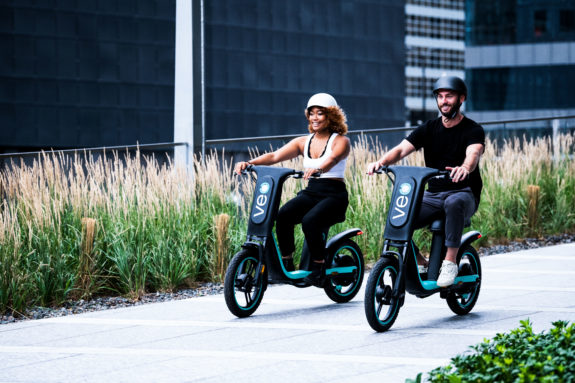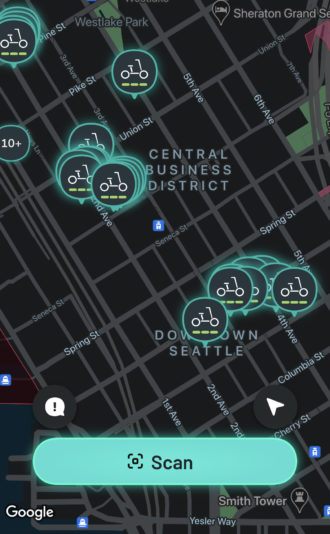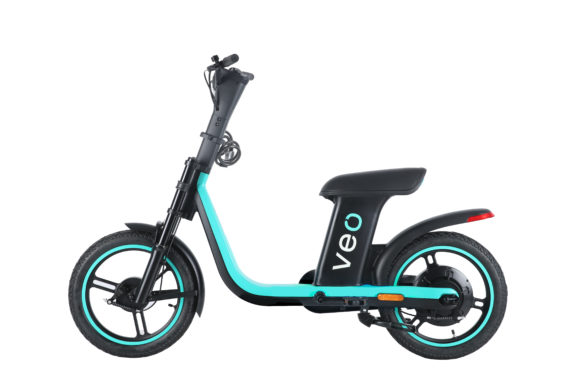

A new bike share competitor has entered Seattle. Today, Chicago-based Veo is rolling out 500 e-bikes onto Seattle streets, the first legitimate bike share competitor to Lime since Lime acquired Jump in spring 2020.
Veo is launching its new Cosmo e-bikes, which are a pedal version of their sit-down electric scooter. Unlike the “pedelec” Lime/Jump bikes, which provide electric assist automatically as you pedal, the Veo Cosmo has a throttle similar to a scooter. So it’s sort of like the Wheels scooters already in operation in Seattle, except you have the option of pedaling in addition to the electric motor. If you have ever tried going up a long hill on a scooter, you can probably see how pedals could be a very welcome addition (I have yet to try Veo, so I can’t say for sure how they handle Seattle’s hills).
Veo’s pricing is also competitive, undercutting both Wheels and Lime by charging $1 to unlock plus 29¢ per minute (to promote their launch, they are waiving the $1 unlock and giving $5 of ride credit with promo code RIDESEA). For comparison, Lime charges $1 plus 36¢ per minute and Wheels charges $1 plus 39¢ per minute (with a $4 minimum). Saving 7–10¢ per minute can add up. A half-hour ride on Veo would be $9.70 compared to $11.80 on Lime or $12.70 on Wheels. Take 10 30-minute rides, and you’ve saved $21 to $30. It will interesting to see if other services lower their prices to match Veo.

The pandemic did a number on bike share use, which works best in dense, bustling business districts like downtown. People took 2.2 million bike share rides in 2019, but that figure plummeted to 316,000 in 2020, David Kroman at the Seattle Times reported. When business and civic activity started to pick up again in late 2020 and into 2021, scooter companies invested in the city as Seattle finally allowed scooter permits. There have been 1.8 million scooter trips so far in 2021 on top of 358,000 bike trips, Kroman reports. So total micromobility use is back to 2019 levels, which is good to see. But bikes have clearly been on the sidelines since 2020, with only Lime operating a limited bike fleet in the city. It is great to see bike competition return to town. Lime currently operates about 1,400 bikes, and Veo plans to reach 1,500 bikes by spring. Seattle hasn’t had 3,000 bikes in operation since 2019.
Have you used the Veo bikes yet? Let us know how it went in the comments below.
Here’s the full press release from Veo:
Veo today announced a partnership with the City of Seattle to bring 1,500 Cosmo e-bikes to the city by spring 2022. Veo will deploy their first 500 e-bikes over the next week, providing travelers with a convenient, affordable, and sustainable option to get to their destinations.
“We are thrilled to be working with the City of Seattle to expand sustainable transportation with our most accessible e-bike yet,” said Candice Xie, Veo chief executive officer. “Veo’s e-bikes will give Seattlites a fun, car-free option to get where they need to go, whether it’s to a neighborhood coffee shop or that last leg from a transit stop.”
“Seattle’s bike share offers a popular, healthy, and enjoyable option to get around the city without driving,” said Seattle Department of Transportation Director Sam Zimbabwe. “This program is an important part of our strategy to reduce pollution and meet our climate goals, and we are excited to expand the program and welcome Veo to Seattle.”
Veo’s unique throttle-assist Cosmo e-bike was designed with a motor and pedals to make it easier for riders of varying body types and physical abilities to ride long distances comfortably while maintaining balance and control. The e-bikes will be helpful for “last-mile” trips like the uphill journey from King Street Station to medical establishments and educational institutions on First Hill. West Seattle residents may also find the e-bikes to be a convenient option for travel during the West Seattle Bridge closure.
“Cascade Bicycle Club is happy to hear about the arrival of the new Veo e-bikes. More bike-share means more active transportation options. Whether for getting to work, connecting to transit, running errands, or just exploring the city, biking is affordable, convenient, good for us, and good for the planet,” said Cascade Bicycle Club Policy Director Vicky Clarke. “Access to bikes can reduce automobile use, reduce traffic congestion, clean up our air and reduce our city’s carbon emissions. We hope that all Seattleites, regardless of neighborhood, will be able to easily access Veo bikes, and we look forward to riding them!”
Veo’s shared e-bike program will bring up to 30 jobs to the city focused on maintenance, rebalancing, responding to needs in the field, and community engagement. Interested applicants can go to veoride.com/careers to apply.
How to Ride
- E-bikes can be located across the city using the free VeoRide app.
- Getting started is simple. Using the Veo app, riders can scan a QR code and pay $1 to unlock the device. Riders then pay a $0.29 per-minute rate for the duration of their trip. For the initial launch period, Veo will waive the $1 unlock fee and Seattle riders can get $5 in free credit with the promo code RIDESEA. People with low incomes can visit veoride.com/veo-access to apply for a discounted rate.
- Upon completion of the ride, users can park the device at designated parking locations or along the furniture line on the sidewalk. Users must take a photo within the app to confirm proper parking and end their ride.
- GPS and LTE technologies enable Veo to track bike locations and geofence areas that are designated as no ride, slow ride, no parking, or recommended parking zones.
About the Cosmo E
The Cosmo E is equipped with the following features:
- Both a motor and pedals, giving users the option of pedaling or using the throttle to get where they want to go.
- A well-balanced frame with a low center of gravity.
- 18-inch alloy wheels for performance and control.
- Active brake lights and glow-in-the-dark painted decals to increase safety and visibility at night.
- A swappable battery system, pioneered from Veo’s stand-up scooters, which let Veo technicians swap the battery pack on site, enabling devices to be available 24/7.
About Veo
Headquartered in Chicago and founded in 2017, Veo is one of micromobility’s fastest growing and most innovative companies. Veo partners with dozens of cities and universities nationwide with exclusive and limited-vendor contracts in its mobility share programs and is adding additional municipalities and campuses every month. Veo’s hands-on design and manufacturing process enables Veo to integrate safety, comfort, compliance, and reliability directly into the hardware, including its unique e-swappable-battery technology, turn signals, and underdeck light messaging to help keep sidewalks clear of fallen scooters. For more information, visit www.veoride.com.








Comments
9 responses to “Veo launches e-bike share in Seattle”
Design looks like it should be a bit more vandalism-resistant as long as the brake-line slasher doesn’t come back – no wire spoke wheels, headlight recessed in the front housing, full chain case.
In the absence of a discount for frequent use, 29 cents per minute is still too high to be attractive for regular use. Buying your own ebike and riding that is far, far cheaper.
Depends on what you’re doing. If you’re riding from your home to a place and back every day, then definitely. But a personal e-bike can’t appear and disappear at will. That’s what’s so great about bike share, especially when combined with transit. You can string trips together, use bike share for intermittent trips, etc. I think of bike share as almost a different mode from a private bike.
It seems the price point is above the sweet spot. Sure, there are some cases where the current pricing makes sense. But it’s expensive.
By comparison, according to
https://www.france-hotel-guide.com/en/blog/electric-scooters-paris/
The price in paris last summer was 1 euro to unlock and 15 to 23 cents per minute. That’s quite a bit cheaper, on average.
On the other hand, Seattle scooter share pricing is still cheaper than ride share for distances of a few miles.
I finally tried scooter share last week – to get home after dropping off my bike to get repaired. Well, normally I would bike but I have to admit, it was convenient to use a scooter. I’m glad we have them.
For comparison, Gig charges $0.49 per minute, for a Toyota Prius, plus $1, plus tax. Not a very big price difference, given the difference in cost of the vehicles.
For some trips, it is actually cheaper to rent a gig car than an ebike or scooter, which is quite insane. The reason: cars move faster than bikes, so a slightly higher cost per minute can still translate into a lower cost per mile. Especially when the car trip is able to use the freeway, and it’s an off-peak time, so there’s no congestion.
One thing I would like to see with the rental bike fleets (and the gig cars as well) is a switch in payment model from per-minute to per-mile. The fact that you’re asked to pay more for your trip due to factors outside your control, such as red lights, bridge openings, or traffic congestion, has always irked me and feels fundamentally unfair. Similarly, I shouldn’t have to pay extra for the time it takes to stop and tweak the seat adjustment, when necessary. Nor should the billing system reward people for riding too fast, making unsafe passes, or running red lights.
Another thing about the billing of these systems that irks me is that there’s no “free transfer” from one bike to another, even of the same company. So, if you start riding and, say, the motor doesn’t work, or the brakes barely work, you can’t switch to another bike without paying another unlock fee, and, sadly, this happens often enough that these extra unlock fees start to add up. It also effectively rewards the company for not properly maintaining their bikes, since every time someone tries a broken bike and switches to another, they get more money, leaving them little reason to actually fix the bike.
I suspect the reason why the companies don’t do this is that they want to hide to the public what their services actually cost. $0.30/min. at 10mph works out to be $1.80/mile, and paying $1.80/mile to ride a bike feels like a rip off. $0.40/min. at 10mph is $2.40/mile, nearly as high as the $2.70/mi. figure posted on the yellow taxis. Granted, bike share rides don’t have tips, but this is still rediculous. Riding a bike should not have a cost-per-mile in the same ballpark as riding in a full-sized car with a paid driver. It just shouldn’t, and the fact that it is points to either price gauging, or a fundamentally broken business model.
Call it what it is: a motorcycle, not an “e-bike”. And somebody somewhere STILL thinks it’s a great idea to unleash these on our sidewalks, bike lanes and multi-use trails.
These things are getting more and more massive, which makes them more difficult to roll onto the roadway when they are constantly abandoned on sidewalks, trails, curb ramps, etc.
Yeah those look JUST like motorcycles.
Annoying but about 1/100 as annoying as vehicles that are perpetually parked any old place. I will take ebikes any day.